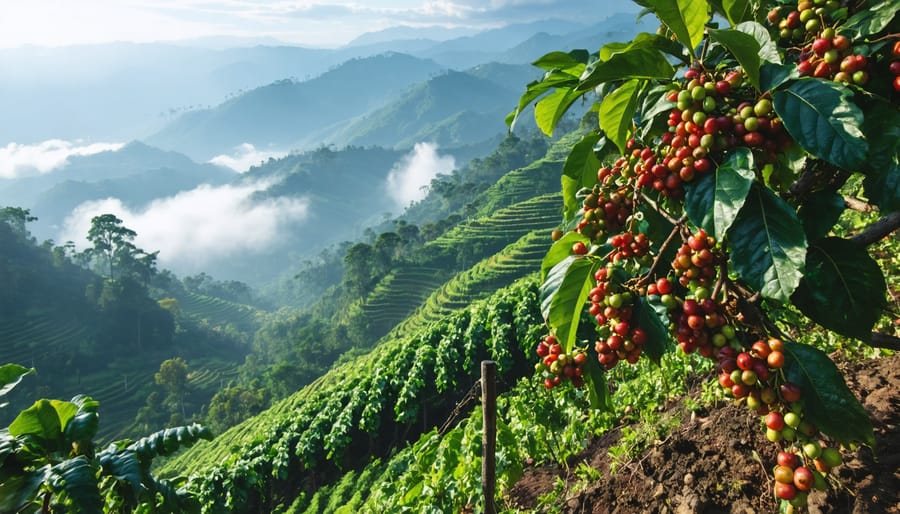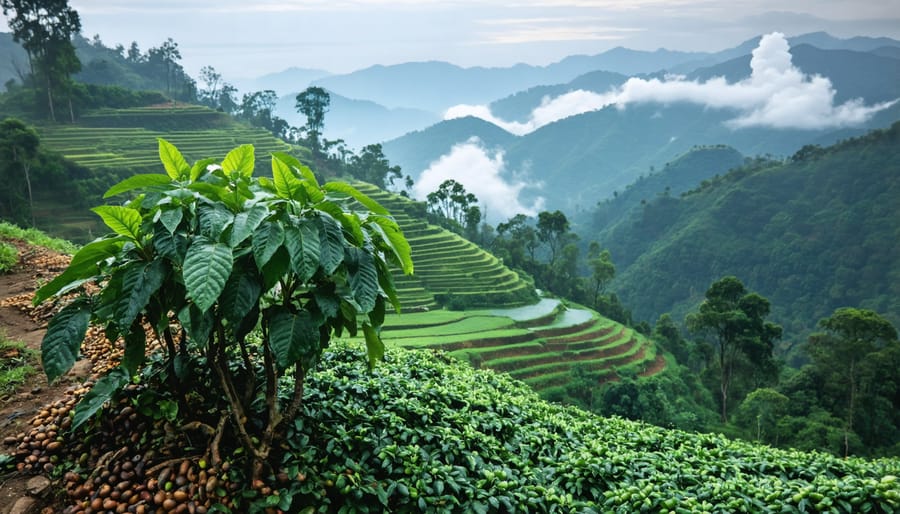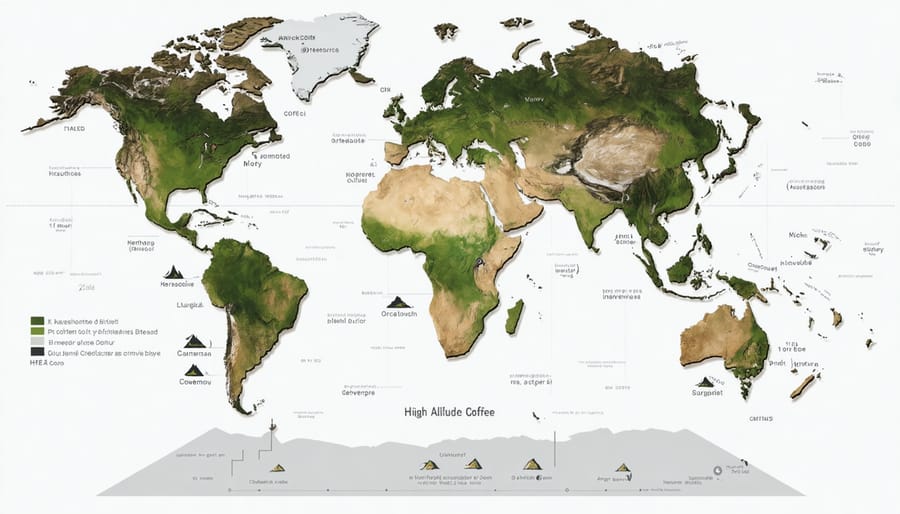
Perched high in the misty mountains, where the air is crisp and thin, grows some of the world’s most extraordinary coffee. At elevations above 4,000 feet, coffee cherries develop more slowly, creating beans with a complexity and brightness that coffee lovers dream about. These high-altitude beans, prized by baristas and connoisseurs alike, tell a fascinating story of how elevation shapes flavor.
Picture this: While your typical coffee might grow in humid lowlands, high-altitude beans face daily temperature swings and challenging growing conditions that actually work in their favor. The struggle makes them stronger, developing denser beans packed with the natural sugars and acids that translate into your morning cup’s bright, complex flavors. Think vibrant citrus notes, delicate floral aromas, and that crisp, clean finish that makes mountain-grown coffee so distinctive.
Whether you’re a curious coffee enthusiast or someone looking to elevate their daily brew, understanding high-altitude coffee opens up a world of exceptional flavors that literally rise above the ordinary.

Why Height Matters: The Science Behind High-Altitude Coffee
The Perfect Stress: How Altitude Challenges Create Better Beans
Just like how we tend to perform better under a bit of pressure, coffee beans follow a similar path when grown at higher altitudes. Picture this: as you climb a mountain, the air gets thinner, temperatures drop, and growing conditions become more challenging. These environmental stressors actually work in favor of our beloved coffee beans!
At high altitudes, coffee plants grow more slowly, giving the beans extra time to develop complex sugars and flavor compounds. It’s nature’s way of turning adversity into advantage! The cooler temperatures and reduced oxygen levels force the plants to work harder, resulting in denser, harder beans packed with intense flavors.
Think of it as the plant’s survival strategy – the tougher growing conditions encourage the coffee cherries to produce more natural oils and sugars to protect themselves. This stress-induced development is what creates those distinct flavor notes that coffee lovers rave about: bright acidity, enhanced sweetness, and wonderful complexity that you just don’t find in beans grown at lower elevations.
I like to call it the “diamond effect” – just as precious gems are formed under pressure, these high-altitude beans transform their challenging environment into something truly extraordinary.
Temperature’s Sweet Spot
Picture yourself hiking up a mountain – the higher you climb, the cooler it gets, right? That same principle works wonders for coffee beans growing at high altitudes. These cooler temperatures are like nature’s slow-cooking method, giving the beans more time to develop their complex flavors and natural sweetness.
I remember visiting a coffee farm in Colombia where the farmer explained how the cool mountain air acts like a patient chef, allowing the coffee cherries to mature gradually. This slower development means the beans have more time to produce and store natural sugars and other flavor compounds that make your morning cup truly special.
Think of it like ripening a tomato – one rushed on a sunny windowsill versus one that slowly matures on the vine. The mountain-grown beans benefit from this unhurried process, developing higher concentrations of natural sugars and more complex flavor profiles. During the day, the beans soak up just enough warmth to keep growing, while the cool nights prevent them from maturing too quickly.
This temperature dance creates beans that are denser, more flavorful, and often have a natural sweetness that coffee lovers can’t resist.
Flavor Notes That Only Mountains Can Make
The Taste Profile
High-altitude coffee beans are celebrated for their distinctive coffee origin flavors that set them apart from their lower-elevation counterparts. Picture biting into a crisp apple – that’s the bright, clean acidity you’ll find in these exceptional beans. The slower growth at high altitudes allows the beans to develop complex sugar compounds, resulting in a sweeter cup with delightful notes of caramel and honey.
When you sip high-altitude coffee, expect to discover layers of flavor that unfold like a beautiful story. You might notice bright citrus notes dancing with dark chocolate undertones, or perhaps hints of berry complementing subtle floral aromas. Many coffee lovers particularly enjoy the silky, medium body that’s characteristic of these beans – it’s never too heavy or overwhelming.
The clean, crisp finish is another hallmark of high-altitude coffee. Unlike lower-grown varieties that might leave a bitter aftertaste, these beans typically end with a pleasant, lingering sweetness. Think of it as nature’s perfect balance: the challenging growing conditions at high elevations create beans with both intensity and refinement, offering a truly elevated coffee experience that’s worth seeking out.

From Farm to Cup
When it comes to brewing high-altitude coffee beans, a few tweaks to your usual routine can help you unlock their full potential. I learned this the hard way when I first brought home some gorgeous beans from a small Costa Rican mountain farm – my regular brewing method just wasn’t doing them justice!
These special beans typically need a slightly lower brewing temperature, around 195-200°F instead of the standard 205°F. The dense structure of high-altitude beans means they benefit from a slightly finer grind than you might usually use. Think powdered sugar rather than granulated sugar consistency.
Pour-over methods work beautifully with these beans, allowing you to control the water flow and really appreciate their complex flavor profiles. I’ve found that extending the bloom time by 10-15 seconds gives the coffee more time to release its distinctive notes.
As for ratios, start with 1:16 (coffee to water) and adjust to taste. Remember, these beans often pack more punch than their lower-altitude cousins, so you might need less coffee than usual to achieve your perfect cup. Don’t be afraid to experiment – every high-altitude bean has its own personality, and finding the right brewing sweet spot is part of the journey!
Finding Your Perfect Mountain Bean
Reading Labels Like a Pro
Have you ever stood in the coffee aisle, staring at bags labeled with different altitude measurements, wondering what they actually mean? Don’t worry – you’re not alone! I used to feel the same way until I learned to decode these coffee labels like a pro.
Generally, coffee altitude classifications fall into three main categories: strictly high grown (SHG), high grown (HG), and central standard (CS). When you see “SHG” on your coffee bag, you’re looking at beans grown at elevations above 4,500 feet – these are the cream of the crop! These high-flyers typically develop more complex flavor profiles with bright, crisp notes that many coffee lovers adore.
“HG” indicates beans grown between 3,000-4,500 feet, offering a pleasant middle ground with well-balanced flavors. Meanwhile, “CS” refers to beans grown below 3,000 feet, which often produce a milder, less complex cup.
But here’s a pro tip: don’t just look for the highest number! While altitude matters, it’s just one piece of the puzzle. I’ve found some incredible medium-altitude beans that rival their higher-grown cousins in taste. The key is understanding that these classifications help you predict the general flavor profile you might expect – higher altitudes typically mean brighter acidity and more pronounced fruit notes, while lower altitudes often deliver smoother, more chocolate-like flavors.
Remember, the best coffee is ultimately the one you enjoy most, regardless of its elevation credentials!
Famous High-Altitude Coffee Regions
When I first discovered high-altitude coffee beans, I was amazed by how each region produces such distinct flavor profiles. Let me take you on a quick tour of some of the world’s most celebrated high-altitude coffee regions!
Ethiopia’s Yirgacheffe region, sitting at elevations between 5,800-7,600 feet, produces beans with delicate floral notes and bright citrus undertones that never fail to brighten my morning. In Guatemala’s Huehuetenango region, where coffee grows at altitudes up to 6,500 feet, you’ll find beans with a complex character featuring honey sweetness and subtle chocolate notes.
Colombia’s Nariño region, with farms reaching heights of 7,500 feet, gives us beans with a lovely balanced acidity and caramel sweetness. One of my personal favorites comes from Kenya’s Nyeri region, where high-altitude farms produce beans with wine-like acidity and berry notes that make for an absolutely gorgeous cup.
Don’t forget about Costa Rica’s Tarrazu region, where beans grown at 4,000-6,000 feet develop bright citrus notes and a clean, crisp finish. And if you’re looking for something truly special, try beans from Peru’s Chanchamayo Valley, where altitudes of 5,600-6,200 feet create coffee with gentle floral notes and hints of nuts and chocolate.
Each of these regions offers something unique, making high-altitude coffee an exciting world to explore!

Making the Most of Your Mountain-Grown Coffee
Ready to unlock the full potential of your high-altitude coffee? Let’s explore some brewing methods that will help you savor every nuanced note these special beans have to offer. When it comes to brewing high-altitude coffee, temperature control is your best friend. Start with water just off the boil, around 195-205°F, to properly extract the complex flavors without scorching the beans.
Pour-over methods work beautifully with mountain-grown coffee, allowing you to control the water flow and really appreciate the bright, clean taste. I’ve found that a medium-fine grind size offers the perfect balance, especially if you’re using a Chemex or V60 brewer. Take your time with the pour, using gentle, circular motions to ensure even extraction.
For those who prefer French press, try a slightly coarser grind and extend the steeping time to 4-5 minutes to fully capture the distinctive flavor notes. Remember to store your mountain-grown beans in an airtight container away from light and heat to preserve their unique characteristics.
Pro tip: Before brewing, try crushing a few beans between your fingers and inhaling deeply – you’ll notice the intensely aromatic qualities that make high-altitude coffee so special. These careful brewing methods will help you experience every subtle note these exceptional beans have to offer.
High-altitude coffee beans truly offer a unique and extraordinary coffee experience that’s worth exploring. Their complex flavor profiles, bright acidity, and rich aromas are a testament to the incredible influence that elevation has on coffee cultivation. As someone who was once a coffee novice myself, I can tell you that discovering these mountain-grown beans completely transformed my morning ritual.
Whether you’re a longtime coffee enthusiast or just beginning to venture beyond your usual cup, I encourage you to try different high-altitude varieties from regions like Colombia, Ethiopia, or Guatemala. Each brings its own distinctive character to your cup, and you might be surprised by which becomes your new favorite.
Remember, when you choose high-altitude coffee, you’re not just treating yourself to superior flavor – you’re also supporting farmers who face unique challenges to bring us these exceptional beans. So go ahead, elevate your coffee experience and savor the remarkable taste that only the mountains can provide.



